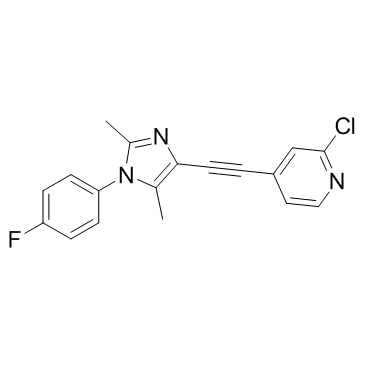802906-73-6
| Name | 2-chloro-4-[2-[1-(4-fluorophenyl)-2,5-dimethylimidazol-4-yl]ethynyl]pyridine |
|---|---|
| Synonyms |
2-chloro-4-{2-[1-(4-fluorophenyl)-2,5-dimethyl-1H-imidazol-4-yl]ethynyl}pyridine
RO4917523 RG-7090 2-Chloro-4-{[1-(4-fluorophenyl)-2,5-dimethyl-1H-imidazol-4-yl]ethynyl}pyridine UNII-3110E3AO8S Basimglurant Pyridine, 2-chloro-4-[2-[1-(4-fluorophenyl)-2,5-dimethyl-1H-imidazol-4-yl]ethynyl]- RG7090 |
| Description | Basimglurant (RG7090) is a potent, selective and orally available mGlu5 negative allosteric modulator with a Kd of 1.1 nM. |
|---|---|
| Related Catalog | |
| Target |
Kd: 1.1 nM (mGlu5)[1] |
| In Vitro | [3H]-basimglurant saturation analysis on recombinant human mGlu5 reveals monophasic saturation isotherms with Kd of 1.1 nM. In competition binding experiments on human recombinant mGlu5, Basimglurant (RG7090) fully displaces [3H]-MPEP with a Ki of 35.6 nM and [3H]-ABP688 with a Ki of 1.4 nM. In HEK293 cells stably expressing human mGlu5, Basimglurant (RG7090) inhibits quisqualate induced Ca2+ mobilization with an IC50 of 7.0 nM and [3H]-inositolphosphate accumulation with an IC50 of 5.9 nM. Basimglurant (RG7090) shows similar potencies in radioligand binding and functional assay on human and rodent mGlu5 receptor orthologues[1]. |
| In Vivo | Basimglurant (RG7090) is a potent, selective, and safe mGlu5 inhibitor with good oral bioavailability and long half-life supportive of once-daily administration, good brain penetration, and high in vivo potency. It has antidepressant properties which are corroborated by its functional magnetic imaging (fMRI) profile, as well as anxiolytic-like and antinociceptive features[1]. It is currently in phase II clinical studies for the treatment of depression and fragile X syndrome. In the Vogel conflict drinking test, Basimglurant dose dependently increases the drinking time. The total plasma exposure of efficacious doses of Basimglurant (RG7090) ranges from 5 ng/mL (0.03 mg/kg) to 37 ng/mL (0.3 mg/kg)[2]. |
| Animal Admin | Rats: For intravenous PK, Basimglurant (RG7090) is formulated in N-methyl-pyrollidone (NMP)/saline (30%/70%) as vehicle and administered at a volume of 2 mL/kg. For oral gavage (p.o.) the compound is administered as suspension using gelatine/saline (7.5%/0.62% in water) at an administration volume of 4 mL/kg[1]. Monkey: For intravenous PK, Basimglurant (RG7090) is formulated in cyclodextrin solution as vehicle and administered at a volume of 2 mL/kg. For oral gavage (p.o.), the compound is administered in capsule (2 mg in size-2 capsules, i.e. ~0.3 mg/kg) to fasted or fed monkeys in a cross-over design[1]. |
| References |
| Density | 1.2±0.1 g/cm3 |
|---|---|
| Boiling Point | 526.6±60.0 °C at 760 mmHg |
| Molecular Formula | C18H13ClFN3 |
| Molecular Weight | 325.767 |
| Flash Point | 272.3±32.9 °C |
| Exact Mass | 325.078217 |
| PSA | 30.71000 |
| LogP | 4.49 |
| Vapour Pressure | 0.0±1.4 mmHg at 25°C |
| Index of Refraction | 1.604 |
| Storage condition | 2-8℃ |
